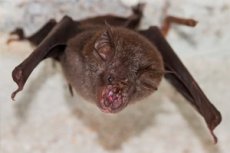Bats discovered to be carriers of new herpes viruses
Sist anmeldt: 14.06.2024

Alt iLive-innhold blir gjennomgått med medisin eller faktisk kontrollert for å sikre så mye faktuell nøyaktighet som mulig.
Vi har strenge retningslinjer for innkjøp og kun kobling til anerkjente medieområder, akademiske forskningsinstitusjoner og, når det er mulig, medisinsk peer-evaluerte studier. Merk at tallene i parenteser ([1], [2], etc.) er klikkbare koblinger til disse studiene.
Hvis du føler at noe av innholdet vårt er unøyaktig, utdatert eller ellers tvilsomt, velg det og trykk Ctrl + Enter.

In a recent study published in Scientific Reports, a team of researchers from Wuhan, China, found that various species of insectivorous bats in central China are natural hosts or reservoirs β- and γ-herpesviruses, with viruses of the Herpesviridae family showing host range restrictions and phylogenetic analysis indicating previous cross-transmissions between species.
Zoonotic diseases have always posed a serious threat to human health and the economy, given that the human immune system and global medical technologies are often not prepared to deal with these viruses that have passed on from other animal species. The coronavirus disease 2019 (COVID-19) pandemic is a prime example of how zoonotic diseases impact human lives and the global economy.
Factors such as living in large groups and having a wide distribution often result in bats acting as reservoirs for a variety of pathogens. Genetic similarities between bats and other mammals such as humans and livestock have led to outbreaks of various zoonotic viruses such as severe acute respiratory syndrome coronavirus (SARS-CoV), Ebola viruses, lyssaviruses and henipaviruses.
Viruses of the Herpesviridae family have linear double-stranded deoxyribonucleic acid (DNA) with genome sizes ranging from 124 to 295 kilobase pairs (kbp). These viruses have been found in many animals, including shellfish, fish, amphibians, reptiles, birds and mammals. Mammalian herpesviruses are divided into three subfamilies: α-, β-, and γ-herpesviruses, and many species of human herpesviruses, such as cytomegalovirus, Epstein-Barr virus, Kaposi's sarcoma-associated virus, and human herpesviruses 6A, 6B, and 7, are known to ability to cause infections with severe morbidity.
In this study, scientists collected different species of insectivorous bats from caves in various areas around the city of Wuhan in Hubei Province and used molecular techniques to determine the presence of herpesviruses in these bats. The epidemiological characteristics of the detected herpesviruses were studied using phylogenetic methods.
Bats were initially identified based on morphology, and the cytochrome b gene was then amplified using polymerase chain reaction (PCR) and sequenced from DNA extracted from these bats to confirm species identification. Genomic DNA obtained from liver and intestinal tissue has also been used to perform nested PCR amplification targeting the dpol DNA polymerase gene in herpesviruses. In addition, the glycoprotein B gene has been used to further characterize herpesviruses.
The Basic Local Alignment Search Tool, or BLAST, provided by the National Center for Biotechnology Information was used to obtain published herpesvirus sequences most similar to those sequenced in this study. The published sequences and those obtained in the study were then used to construct phylogenetic trees to understand the relationships between newly discovered and previously identified herpesviruses. Cytochrome b sequences generated for bat species were also used to construct host phylogenetic trees to determine patterns of correlation between herpesviruses and their hosts.
The study found four strains of the genus Betaherpesvirus and 18 strains of Gammaherpesvirus in 22 of the 140 bats collected. In the bat species Rhinolophus pusillus or the lesser horseshoe bat, the prevalence of herpes viruses was 26.3%, while in the microbat species Myotis davidii it was 8.4%. The most frequently detected γ-herpesvirus strain was strain RP701, which also had the greatest similarity to the ruminant γ-herpesvirus. One of the other Gammaherpesvirus strains, MD704, showed the greatest similarity to hedgehog γ-herpesvirus.
The distribution range of M. Davidii extends from the central to northern regions of China, while R. Pusillus is found in the Indo-Malayan region. Other studies have also identified the herpesvirus strain RP701 in bats found in southern China, indicating that RP701 is widespread and shares a common ancestor with a herpesvirus found in ruminants.
In addition, four β-herpesviruses have been identified in M. Davidii and show 79% to 83% similarity to known β-herpesviruses. These β-herpesviruses also belonged to the same clade as β-herpesviruses identified in other bats from the family Vespertilionidae, to which M. Davidii belongs. These results suggest that the new β-herpesviruses may have hosts other than M. Davidii, and that close contact between individuals of different species of the family Vespertilionidae in colonies could facilitate interspecific transmission of these β-herpesviruses.
To summarize, the study identified four new strains of β-herpesviruses and 18 new strains of γ-herpesviruses in 22 bats collected from areas around the city of Wuhan. Two of the common strains share similarities with herpesviruses found in ruminants and hedgehogs, indicating potential for transmission to other mammals and possible outbreaks of zoonotic diseases.
These results highlight the need for continued surveillance of large bat populations and monitoring of viral reservoirs in these hosts to ensure preparedness for potential zoonotic disease outbreaks.
